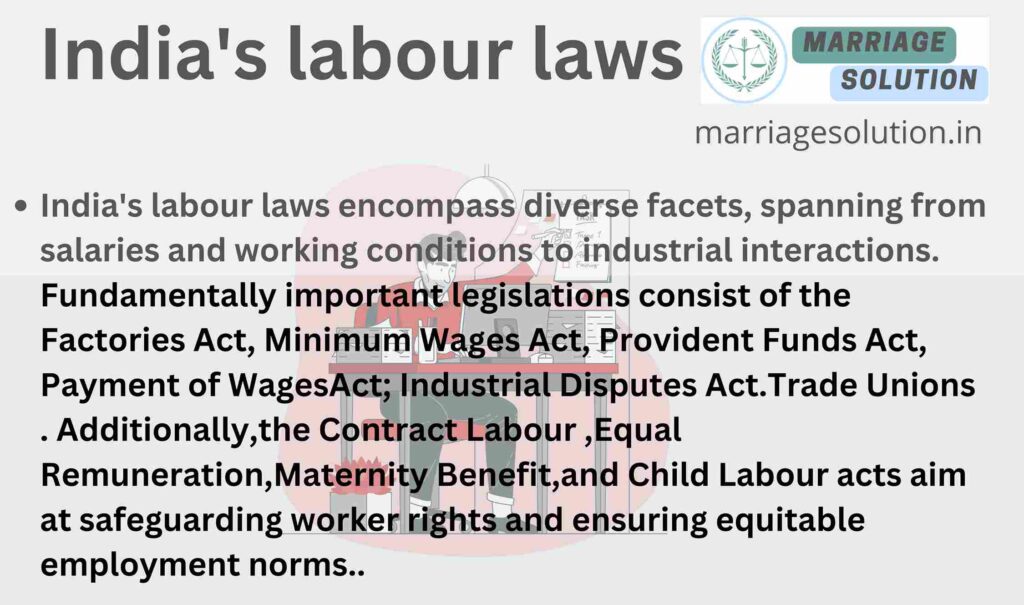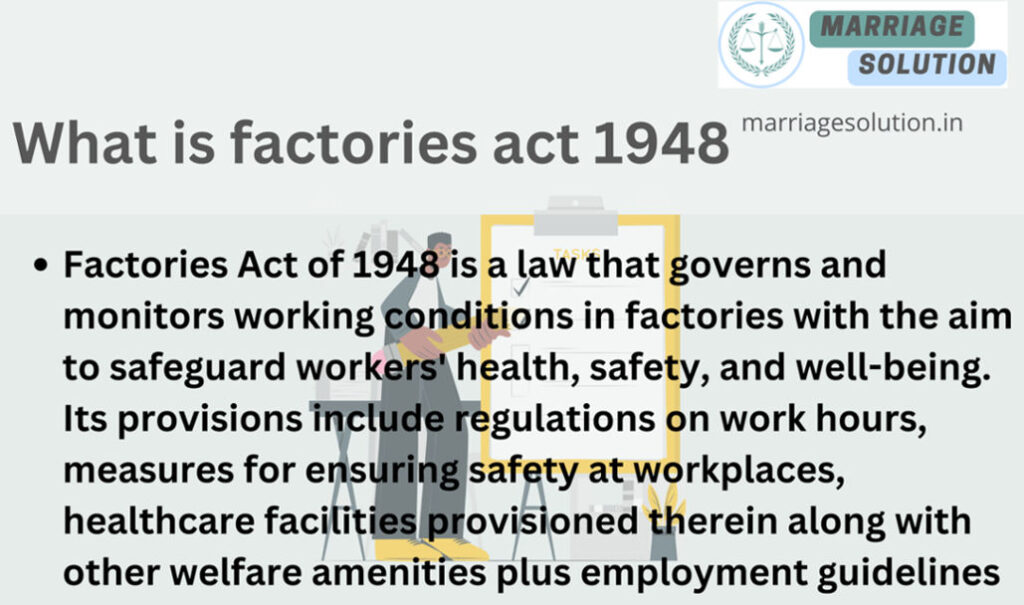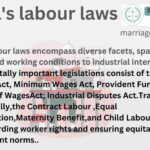The work regulations in India serve as guidebooks, aimed at protecting workers and ensuring they are treated justly while on the job. These guidelines encompass various aspects such as remuneration policies, workplace safety protocols, and employee benefits provisions. They endeavor to create a safe working environment for every individual by enforcing minimum wage standards, guaranteeing factory safety measures or offering maternity leave options. It is crucial that both employers and employees comprehend these rules since it paves way towards establishing fair employment practices within an organization. By adhering to these laws carefully one can ensure ethical conduct is sustained throughout their professional ecosystem thereby creating a healthy workspace conducive for growth of individuals involved in this ecosystem .

India labour act
Indian Labour Act, broken down point-wise:
1)The Lowest pay permitted by law Regulation ensures fair compensation for laborers, shields them against abuse and backers for money correspondence.
2) Factory Laws: The regulations relating to industrial facilities order severe security guidelines that envelop wellbeing conventions, work hours and break arrangements. These actions are intended to make a safe working climate advancing representative prosperity.
3)Employee Provident Fund (EPF) Act: The EPF Act specifies that businesses should outfit assets to maintain their representatives’ monetary prosperity during post-retirement age, in this manner cultivating an enduring monetary manageability.
4)Employees’ State Insurance (ESI):ESI or Representatives’ State Protection offers fundamental medical care advantages to work on the government assistance of representatives. It incorporates inclusion for working environment related diseases and inabilities, guaranteeing their general prosperity.
5)Labor Disputes Law: The objective of Work Debates Regulation is to supervise a smooth goal process for conflicts among bosses and representatives through protest methodology and intervention assets, with a definitive target of guaranteeing evenhanded and fair-minded results.
6)Maternity Benefits Acts: The Maternity Advantages Acts defend ladies’ working environment freedoms by guaranteeing that female representatives are qualified for maternity leave and different advantages, accordingly safeguarding them against biased rehearses.
7)Equal Pay Legislation: The Equivalent Compensation Regulation means to dispense with orientation based installment aberration’s, guaranteeing reasonableness and uniformity in all work environments while establishing assorted and comprehensive workplaces.
Important Labor Laws:
1)Minimum Wages Act, 1948:The Base Wages Demonstration of 1948 lays out a fair pay for different laborers by setting the lowest pay permitted by law guidelines. This guarantees that they are repaid properly for the work performed.
2)Factories Act 1948:The Production lines Demonstration of 1948 manages work in plants to guarantee the security, wellbeing, government assistance and working long periods of laborers.
3)Industrial Disputes Act, 1947:The Modern Debates Demonstration of 1947 sets out conventions to resolve clashes among businesses and representatives, enveloping instruments for strikes, lockouts, and dealings with one another.
4)Employees’ Provident Fund and Miscellaneous Provisions Act, 1952 :The Representatives’ Fortunate Asset and Incidental Arrangements Demonstration of 1952 orders managers and workers to make commitments towards an opportune asset. The essential objective behind this arrangement is to get the monetary eventual fate of representatives post-retirement.
5)Employees’ State Insurance Act, 1948 :The Representatives’ State Protection Act, 1948 offers clinical and cash advantages to workers and their wards in instances of business related injury, birth, handicap or passing.
6)Workmen’s Compensation Act, 1936:The 1936 Follow up on Workers’ Remuneration commands the brief payment of wages to representatives and controls allowances from their compensations.
7)Maternity Benefits Act, 1961:The Maternity Advantages Demonstration of 1961 specifies that female specialists are qualified for maternity leave and different advantages while pregnant or conceiving an offspring.
8)Child Labor (Prohibition and Regulation) Act, 1986:In 1986, the Kid Work (Restriction and Guideline) Act was established to prohibit the work of underage kids while empowering the administration of work for laborers who are of specific ages or youthful.
Equal Pay Act, 1976:The Equivalent Compensation Demonstration of 1976 forestalls segregation in pay in light of orientation and guarantees that equivalent work gets equivalent remuneration.
9)The Labor Law (Regulation and Abolition) Act, 1970:In 1970, the Work Regulation (Guideline and Abrogation) Act was acquainted with direct the exercises of provisional laborers and assurance their equitable remuneration.
10)Occupational Safety Boards: Various states have set up sheets or commissions devoted to word related wellbeing. Their essential capabilities incorporate managing work regulations, tending to complaints, and pushing for representative prosperity.
The public authority has started changes in the law to smooth out and synchronize assignments by limiting it into less, yet more coordinated guidelines. This drive incorporates carrying out the Focal Work Code pointed toward advancing adherence and improving business practicality.
labour relations act
Some Indian labour :
1)The Payment of Gratuity Act, 1972 : The Installment of Tip Act, 1972 commands that businesses should offer tip – a money related token communicating appreciation for their workers’ administrations to the people who resign, leave or pass away.
2)The Employees’ State Insurance Act of 1948:The Representatives’ State Protection Demonstration of 1948 awards clinical and financial advantages to laborers as well as their relatives in case of ailment, pregnancy, handicap or casualty coming about because of business related wounds.
3)The Contract Labour (Regulation and Abolition) Act of 1970:The Provisional work (Guideline and Nullification) Demonstration of 1970 directs the recruiting system of contractors, forcing a command for just pay and satisfactory work spaces much the same as those managed the cost of ordinary staff.
4)The Child Labour: (:The Youngster Work (Forbiddance and Guideline) Demonstration of 1986 has the objective of annihilating kid work. It refuses utilizing kids under a specific age, while likewise setting rules for working circumstances that youths should observe.
5)The Equal Remuneration Act of 1976:The Equivalent Compensation Demonstration of 1976 prohibits wage segregation based on orientation and ensures that the two sexes get fair pay for identical work.
6)The Shops and Establishments Act: The Shops and Foundations Act is authorized in each territory of India, administering the functional hours, working climate, and other appropriate perspectives concerning business substances containing workplaces, cafés or shops.
7)The Payment of Bonus Act in 1965:The Installment of Reward Act in 1965 expects bosses to concede rewards to qualifying laborers as per their work result and accomplishments, consequently broadening beneficial money related benefits.
factories act 1948
1)Factory Definition: As per the Demonstration’s definition, a plant alludes to any foundation that utilizes at least ten specialists in involving power for assembling processes. In any case, in the event that no power is utilized, production lines utilizing something like twenty people meet the edge prerequisite.

2)Working Hours: The expectation on working hours lays out a passable cutoff for the quantity of work hours of the day and week, alongside guidelines with respect to additional time to guarantee that sensible working times are kept up with for representatives.
3)Health and Wellbeing: he arrangement of reasonable security measures, cleanliness and air course inside the plant premises is necessary under Wellbeing and Wellbeing guidelines. Furthermore, precautionary measures for risky activities are itemized in this regulation.
4)Welfare Measures: Production lines should offer different government assistance offices like bottles, medical aid administrations and bathrooms to guarantee the prosperity of their workers.
5)Prohibition of Work of Small kids: The Demonstration puts a denial on utilizing little youngsters specifically cycles to guarantee their privilege to instruction and safeguard them from dangerous work.
6)Annual Leave with Wages: The Yearly Leave with Wages proviso ensures that representatives are qualified for took care of time with the end goal of rest and diversion.
7)Working Circumstances: The Demonstration presents rules for keeping up with neatness, fitting temperature, and very much managed mugginess in workplaces to guarantee ideal working circumstances.
8)Safety Measures : for Risky Cycles To guarantee wellbeing during perilous cycles, processing plants have executed unique arrangements that require extra measures and insurances.
9)Appointment of Government assistance Officials: Government assistance Officials Arrangement: to keep an eye on the government assistance prerequisites of laborers, bigger production lines are committed to relegate assigned government assistance officials.
10)Penalties for Infringement: There are punishments determined in the Represent encroachments, with an emphasis on sticking to its arrangements.
labour laws in HR
Labour laws play a crucial role in human resources (HR) management, shaping the employer-employee relationship, ensuring fair practices, and protecting the rights of workers. Here’s an overview of how labour laws impact HR functions labour court lawyer.
1)Employment Contracts: The agreements of business contracts, like wages, working hours, leave privileges, and end methodology are administered by work regulations.
2)Minimum Compensation Requirements: Minimum wage guidelines are set up by administrators to guarantee that specialists get only compensation for their work.
3)Working Hours and Overtime: The regulations in regards to Working Hours and Extra time specify the greatest everyday or week by week length a representative can work, while likewise requiring installment at a higher rate for any extra hours worked outperforming these typical cutoff points.
4)Health and Wellbeing Standards: Employers are expected by guidelines to guarantee that their representatives work in a solid and sound climate. They should carry out safeguard measures to stay away from mishaps, word related dangers, and infections related with the work environment.
5)Equal Work Opportunity: In consistence with work regulations, segregation isn’t allowable in that frame of mind of business like enrollment, employing, advancement or end in view of qualities including race, orientation character and articulation, age bunch connection , religious convictions/religion direction , actual lack of ability/handicaps or sexual inclinations.
6)Employee Advantages and Welfare: In request to guarantee the government assistance and monetary security of workers, regulation expects managers to offer explicit advantages, for example, medical coverage, retirement plans, took care of time, and maternity/paternity leave.
7)Trade Associations and Aggregate Bargaining: According to work regulations, representatives have the option to lay out worker’s guilds and participate in aggregate dealing with their managers. Besides, they might participate in modern activity for of shielding their inclinations.
8)Labour Debate Resolution: Regulations exist to work with the goal of work questions among managers and representatives, involving intervention and discretion systems as well as settlement by either work councils or courts.
9)Employment of Extraordinary Categories: Special business classes like ladies, kids, people with handicaps and traveler laborers are dependent upon explicit regulations that ensure their freedoms and defend them from all types of abuse or unjustifiable practices in the work environment.
10)Compliance and Enforcement: To guarantee adherence to work regulations and guidelines, bosses should go along. Resistance can prompt administrative specialists forcing punishments, fines or lawful activity.
Understanding Labour Law Cases? A Guide to Labour Court Lawyers
A labour court lawyer is a legal professional who specializes in handling cases related to labour and employment law. Here are key points about the role of a labour court lawyer:
1)Specialization in Employment: Trial lawyers specialize in matters related to employment, workers’ rights, and disputes between employers and employees.
2) Employment Lawyers: These lawyers have in-depth knowledge of labor law, office-employee quality, including laws, regulations and labor relations procedures.
3)Dispute: Trial lawyers represent clients in disputes such as unfair dismissal, discrimination, wage discrimination and workplace harassment.
4)Collective Bargaining: They can help unions or employers negotiate collective bargaining agreements and resolve disputes arising from these agreements.
5)Employment Contracts: Trial lawyers help draft, review and interpret employment contracts to ensure that the employment contract complies with employment law.
6)Litigation: If the dispute cannot be resolved by negotiation or other means, lawyers appear in court on behalf of the applicant, present the case and argue on behalf of the applicant.
7)Negotiation and Resolution: They may also engage in other forms of problem solving, such as mediation and arbitration, to resolve disputes outside of court.
8)Compliance: Trial lawyers advise employers on legal compliance, helping them comply with laws and business regulations and avoid legal problems. Work hard enough and just pay.
9)Endnotes: Trial lawyers work in a day of change in employment law, court decisions and legislation that will affect their clients.
10)Customer Representatives: They represent individuals, organizations or institutions that work on legal matters, provide legal consultancy and provide legal representation.
what is labour law
Labour law governs the relationship between employers and employees, covering issues like wages, working conditions, safety, and termination procedures. It aims to protect the rights of workers while ensuring fair treatment and compliance with legal obligations by employers.
What is the minimum wage?
The minimum wage is the lowest wage that employers are legally allowed to pay their employees. It is set by the government and varies by jurisdiction.
What are overtime laws?
Overtime laws require employers to pay employees a higher rate of pay for hours worked beyond a certain threshold in a workweek, typically 40 hours in many jurisdictions.
What is harassment in the workplace?
Workplace harassment is unwelcome conduct based on race, color, religion, sex (including pregnancy), national origin, age (40 or older), disability, or genetic information. Harassment becomes unlawful when it is so frequent or severe that it creates a hostile or offensive work environment or when it results in an adverse employment decision.
What does labor law cover?
Labor law covers a wide range of issues including wages, working hours, workplace safety, discrimination, harassment, benefits, and the rights and responsibilities of employers and employees.
Indian government website for labour law
https://labour.gov.in This official website provides valuable information and resources related to labour laws, policies, and initiatives in India. Visitors can access a wide range of information
If you require assistance with court or any other Cases.
court or any other marriage-related issues, our Home – MarriageSolution.in: Your Trusted Partner in Family Legal Matters. Law Services, IPC Section blog, Expert Advice, court cases lawyer help. website may prove helpful. By completing our enquiry form and submitting it online, we can provide customized guidance to navigate through the process effectively. Don’t hesitate to contact us for personalized solutions; we are here to assist you whenever necessary!
Read more
Read more: Indian Labour law : Your Comprehensive Guide (Part 1)- AFSPA Act
 AFSPA act mean Armed Forces Special Powers Act (AFSPA) grants special powers to the Indian Armed Forces in areas classified as “disturbed” due to significant insurgency or internal disturbances.
AFSPA act mean Armed Forces Special Powers Act (AFSPA) grants special powers to the Indian Armed Forces in areas classified as “disturbed” due to significant insurgency or internal disturbances. - Right to Information RTI act :Your Comprehensive Guide (Part 1)
 The Right to Information (RTI) Act : Explore the essence of the Right to Information (RTI) Act through this symbolic image. The image features legal documents, emphasizing the importance of transparency and accountability in governance. The scales of justice represent the balance achieved through the citizens’ right to access information.
The Right to Information (RTI) Act : Explore the essence of the Right to Information (RTI) Act through this symbolic image. The image features legal documents, emphasizing the importance of transparency and accountability in governance. The scales of justice represent the balance achieved through the citizens’ right to access information. - What is Article 371 of Indian Constitution ?Article 371 of the Indian Constitution grants special provisions to specific states and regions within India, addressing their unique historical, social, and cultural circumstances. These provisions aim to accommodate diverse needs and protect cultural identities within the constitutional framework.
- Indian Labour law : Your Comprehensive Guide (Part 1)
 The purpose of labour laws is to safeguard employees and guarantee equitable treatment at the workplace, encompassing aspects such as remuneration, security, and perks. These regulations establish a secure ambiance by imposing minimum wage requirements, ensuring factory safety measures are implemented effectively while granting rights like maternal leave entitlements. Abiding by these principles promulgates an impartial work culture encapsulating upright conduct; thereby cultivating conducive surroundings for progressive development.
The purpose of labour laws is to safeguard employees and guarantee equitable treatment at the workplace, encompassing aspects such as remuneration, security, and perks. These regulations establish a secure ambiance by imposing minimum wage requirements, ensuring factory safety measures are implemented effectively while granting rights like maternal leave entitlements. Abiding by these principles promulgates an impartial work culture encapsulating upright conduct; thereby cultivating conducive surroundings for progressive development. - GST :Your Comprehensive Guide (Part 1 – Understanding the Basics)
 The Goods and Services Tax (GST) is like a big change in how we pay taxes in India. It started on July 1, 2017, and it’s here to simplify things. Before GST, we had many different taxes, and it could get confusing. Now, with GST, it’s like combining all those taxes into one. The idea is to make taxes more straightforward, clear, and fair for everyone. It applies to almost everything we buy or sell, and it’s helping India’s businesses and economy work better together. So, GST is not just a tax change; it’s a step towards making things simpler and better for all of us.
The Goods and Services Tax (GST) is like a big change in how we pay taxes in India. It started on July 1, 2017, and it’s here to simplify things. Before GST, we had many different taxes, and it could get confusing. Now, with GST, it’s like combining all those taxes into one. The idea is to make taxes more straightforward, clear, and fair for everyone. It applies to almost everything we buy or sell, and it’s helping India’s businesses and economy work better together. So, GST is not just a tax change; it’s a step towards making things simpler and better for all of us.
